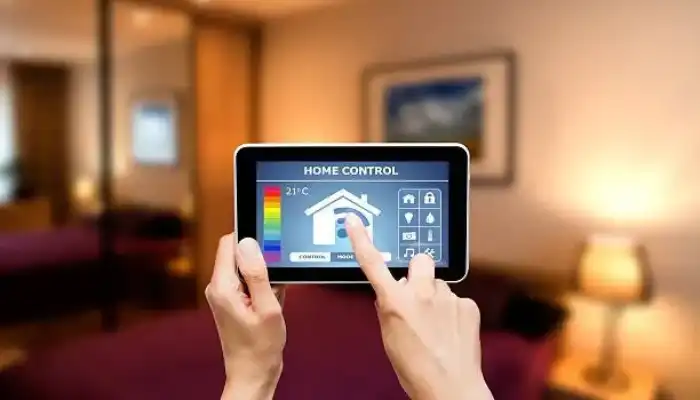The concept of a smart home, brimming with automated devices controlled from your smartphone or even by voice, has captured the imagination of many. Smart home devices, ranging from thermostats to lighting systems and security cameras, promise a world of convenience, efficiency, and security.
But before you dive headfirst into smart home technology, it’s crucial to weigh the advantages against the potential drawbacks. This article will provide a comprehensive analysis to help you decide if smart home devices are worth the investment.

The Rise of the Smart Home: A Connected Future
Smart home devices are essentially electronic appliances and systems equipped with connectivity features. This allows them to be controlled remotely through a smartphone app, voice assistant, or even automated based on pre-set schedules or triggers. The smart home market is experiencing exponential growth, with an increasing number of devices and functionalities constantly emerging.
Benefits of Smart Home Devices
There’s no denying the appeal of a smart home. Here are some of the key advantages that make this technology so enticing:
- Convenience at Your Fingertips: Imagine adjusting your thermostat from the comfort of your couch or turning on lights before you even reach the door. Smart home devices offer unparalleled convenience by allowing you to control your home environment remotely or through voice commands.
- Energy Efficiency and Cost Savings: Smart thermostats that learn your habits and adjust temperatures accordingly can significantly reduce energy consumption. Smart lighting systems that automatically turn off in unoccupied rooms can also contribute to lower energy bills. Over time, these savings can offset the initial investment cost.
- Enhanced Security and Peace of Mind: Smart security systems with motion sensors, doorbell cameras, and remote locking capabilities provide a robust layer of security for your home. You can monitor your property remotely and receive instant alerts of any suspicious activity, offering greater peace of mind.
- The Power of Integration: Many smart home devices work seamlessly together, creating a truly integrated ecosystem. For example, you can set up a routine where turning off your lights triggers your thermostat to switch to sleep mode. This level of integration allows for a more cohesive and efficient smart home experience.
Table 1: Advantages of Smart Home Devices
| Advantage | Description |
| Convenience | Remote control and automation for increased ease of use. |
| Energy Efficiency | Potential for significant reduction in energy consumption and cost savings. |
| Enhanced Security | Robust security features offering peace of mind. |
| Integration | Seamless interaction between devices for a cohesive ecosystem. |
Considering the Costs: Investing in a Smarter Future
The cost of smart home technology is a significant factor to consider. Here’s a breakdown of the financial aspects:
- Initial Investment: Smart home devices can range in price from relatively affordable to quite expensive, depending on the features and functionalities offered. There’s also the potential cost of professional installation for some complex systems.
- Long-Term Savings: While the upfront cost might seem high, the potential for energy savings from smart thermostats and lighting systems can translate to significant cost reductions over time.
- Traditional Device Comparison: Compare the cost of smart devices to their traditional counterparts. While a smart thermostat might be more expensive initially, its energy-saving features might outweigh the cost of a standard thermostat in the long run.
- Maintenance and Upgrades: Some smart home devices may require ongoing subscriptions or maintenance fees. Additionally, upgrading your system as technology evolves may incur additional costs.
Table 2: Cost Considerations for Smart Home Devices
| Factor | Description |
| Initial Investment | Cost of devices and potential installation fees. |
| Long-Term Savings | Potential for energy reduction and cost savings. |
| Traditional Device Comparison | Cost comparison with non-smart alternatives. |
| Maintenance and Upgrades | Potential ongoing costs for subscriptions and upgrades. |
Potential Drawbacks of Smart Home Technology
While smart homes offer a plethora of benefits, there are also some potential drawbacks to consider:
Privacy and Security Concerns:
Smart home devices collect data about your habits and routines. This data, which can include things like when you’re home, what temperature you prefer, and even which lights you turn on most often, is transmitted over your network and stored by the device manufacturer or service provider. Security breaches can expose this data to hackers, raising concerns about privacy invasion. Additionally, malware attacks could potentially take control of your smart devices, compromising the security of your home.
Compatibility Issues:
The smart home market is fragmented, with various proprietary protocols and communication standards. This can lead to compatibility issues between devices from different manufacturers. Ensure that the devices you choose are compatible with each other and work seamlessly within your existing ecosystem.
Dependence on Stable Internet Connection:
Most smart home devices rely on a stable internet connection to function properly. If your internet goes down, you may lose control of your smart devices or experience disruptions in their functionality. This can be particularly inconvenient for features like security systems or remote thermostat control.
Learning Curve for Setup and Usage:
Setting up and using smart home devices can involve a learning curve. You may need to download apps, configure settings, and familiarize yourself with the user interface for each device. This can be time-consuming and frustrating for some users, especially those who are not tech-savvy.
Table 3: Potential Drawbacks of Smart Home Devices
| Drawback | Description |
| Privacy and Security Concerns | Data collection and potential for security breaches. |
| Compatibility Issues | Difficulty in using devices from different brands together. |
| Dependence on Stable Internet | Functionality disrupted by internet outages. |
| Learning Curve for Setup and Usage | Time and effort are required to set up and use devices. |
Factors Influencing the Decision to Invest in a Smart Home
(A) Identifying Needs and Preferences
The first step towards a successful smart home is a clear understanding of your individual needs and preferences. Here are some key questions to consider:
- What are your pain points? Do you struggle to remember to adjust the thermostat? Do you worry about forgetting to lock the door? Identifying your frustrations can guide you towards smart solutions.
- How tech-savvy are you? Setting up and using smart home devices can involve a learning curve. Be honest about your comfort level with technology.
- What is your lifestyle like? If you’re constantly on the go, remote access features might be valuable. If you prioritize energy efficiency, smart thermostats and lighting systems can be game-changers.
(B) Aligning with Your Routine: Compatibility with Daily Life
Smart home devices should complement your lifestyle, not disrupt it. Consider how these devices would integrate into your daily routines:
- Morning Symphony: Imagine waking up to gradually brightening lights and the aroma of coffee brewing automatically.
- Peace of Mind While Away: Smart security systems with remote monitoring and real-time alerts can offer peace of mind when you’re not home.
- Effortless Evenings: Imagine dimming the lights and adjusting the thermostat for a cozy movie night, all with the touch of a button or a voice command.
Table 1: Potential Impact of Smart Home Devices on Daily Life
| Activity | Smart Home Integration |
| Morning Routine | Automated lighting, smart coffee maker |
| Security | Remote monitoring, smart locks, door and window sensors |
| Relaxation | Smart lighting control, temperature adjustment |
| Entertainment | Automated home theater setup, voice-controlled music streaming |
By understanding how smart home technology can enhance your daily routines, you can make informed decisions about which devices would be most beneficial.
© Investing in the Future: Long-Term Benefits vs. Short-Term Costs
The initial investment in smart home devices can be a deterrent. However, consider the long-term benefits:
- Energy Savings: Smart thermostats and lighting systems can significantly reduce energy consumption, leading to lower utility bills over time.
- Increased Security: Smart security systems can deter break-ins and provide valuable evidence in case of an incident, potentially leading to lower insurance premiums.
- Enhanced Convenience: The time saved on repetitive tasks like adjusting the thermostat or locking doors can add up significantly.
Remember: The convenience and efficiency gained from a smart home can have a positive impact on your overall quality of life.
(D) Navigating the Tech Landscape: Influential Decision Factors
Several factors beyond personal needs influence the decision to embrace a smart home:
- Technological Advancements: The smart home market is constantly evolving. Research current trends and upcoming innovations to ensure your choices are future-proof.
- Early Adopter Feedback: Read reviews and testimonials from early adopters to gain insights into the real-world functionality of smart home devices.
- Budget Constraints: Smart home devices range in price. Set a realistic budget and prioritize features that align with your needs.
- Scalability and Futureproofing: Consider how your smart home can grow with your needs. Choose devices that are compatible with each other and allow for future expansion.
Table 2: Factors Influencing the Decision to Invest in a Smart Home
| Factor | Description |
| Technological Advancements | Staying informed about current trends and future innovations. |
| Early Adopter Feedback | Learning from reviews and testimonials of users who have already adopted smart home technology. |
| Budget Constraints | Setting a realistic budget and prioritizing features that align with your needs. |
| Scalability and Futureproofing | Choosing devices that can be expanded upon and integrated with future technologies. |
Conclusion
So, are smart home devices worth the investment? It depends! Weigh the pros and cons carefully. Consider your needs, budget, and tech-savviness. Smart homes offer convenience, security, and potential energy savings, but there are privacy concerns and a learning curve. Do your research, explore alternatives, and see if a smart home can truly enhance your life.


